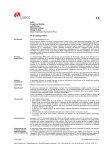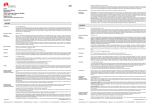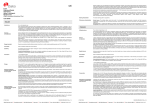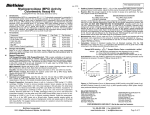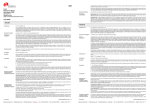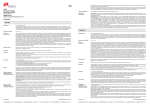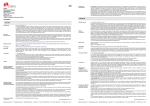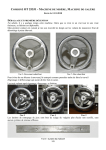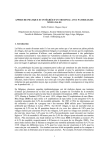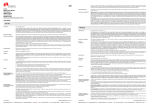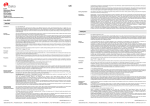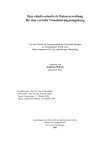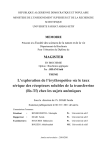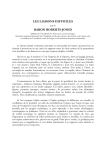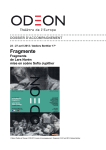Download FLEX Polyclonal Rabbit Anti-Human Myeloperoxidase
Transcript
Optimal conditions may vary depending on specimen and preparation methods, and should be determined by each individual laboratory. If the evaluating pathologist should desire a different staining intensity, a Dako Application Specialist/Technical Service Specialist can be contacted for information on re-programming of the protocol. Verify that the performance of the adjusted protocol is still valid by evaluating that the staining pattern is identical to the staining pattern described in “Performance characteristics”. FLEX Polyclonal Rabbit Anti-Human Myeloperoxidase Ready-to-Use (Dako Autostainer/Autostainer Plus) Counterstaining in hematoxylin is recommended using EnVision FLEX Hematoxylin (Dako Autostainer/Autostainer Plus) (K8018). Nonaqueous, permanent mounting medium is recommended. Positive and negative controls should be run simultaneously using the same protocol as the patient specimens. The positive control tissue should include tonsil and liver and the cells/structures should display reaction patterns as described for this tissue in “Performance characteristics” in all positive specimens. The recommended negative control reagent is FLEX Negative Control, Rabbit (Dako Autostainer/Autostainer Plus) (Code IS600). Code IS511 Staining interpretation The cellular staining pattern is cytoplasmic. Performance characteristics Normal tissues: The antibody strongly labels myeloid cells at all stages of maturation. Cells of monocytic derivation reveal variable reactivity and are typically weakly positive or nonreactive. Erythroid precursors, megakaryocytes, lymphoid cells, plasma cells, dendritic reticulum cells, mast cells and blood vessels are negative. Occasional histiocytes are labeled, some possibly due to phagocytosed material (1). ENGLISH Intended use Abnormal tissues: Anti-myeloperoxidase labels myeloblasts and immature myeloid cells of acute myelogenous leukemia, progranulocytic leukemia, monomyelocytic leukemia, erythroleukemia, myeloblastoma (1). This antibody does not label cells of lymphoblastic lymphoma or leukemia, chronic lymphocytic leukemia, hairy cell leukemia, non-Hodgkin’s lymphoma or T- or B-cell type, Hodgkin’s disease (1). For in vitro diagnostic use. FLEX Polyclonal Rabbit Anti-Human Myeloperoxidase, Ready-to-Use, (Dako Autostainer/Autostainer Plus), is intended for use in immunohistochemistry together with Dako Autostainer/Autostainer Plus instruments. The antibody labels myeloperoxidase-positive cells in normal and neoplastic tissues and is a useful tool for the discrimination between lymphoid and myeloid disorders. Positive results aid in the classification of neoplastic tissue (i.e. myeloblasts and immature myeloid cells of acute myelogenous leukemia, progranulocytic leukemia, monomyelocytic leukemia, erythroleukemia and myeloblastoma) (1). The clinical interpretation of any staining or its absence should be complemented by morphological studies using proper controls and should be evaluated within the context of the patient's clinical history and other diagnostic tests by a qualified pathologist. Summary and explanation Myeloperoxidase (MPO) is composed of two 55-60 kDa subunits and two 10-15 kDa subunits (3). It is a major constituent of the azurophilic granules of neutrophil granulocytes and is also found in the lysosomes of monocytes. In vivo, MPO catalyzes the formation of antimicrobial oxidizing and halogenating agents, e.g. hypochlorous acid from hydrogen peroxide and chloride ions (1, 5). MPO is an important marker for myeloid cells, from the promyelocyte stage and to the mature forms (1). Sensitive immunocytochemical visualization methods, combined with efficient epitope unmasking techniques, have revealed that 17-23% of precursor B-cell acute lymphoblastic leukemias also express MPO, making it very important to use anti-MPO together with antibodies to e.g CD3, CD79α and terminal deoxynucleotidyl transferase (TdT) in the immunohistochemical evaluation of acute leukemias (2, 3). FRANÇAIS Utilisation prévue Pour utilisation diagnostique in vitro. FLEX Polyclonal Rabbit Anti-Human Myeloperoxidase, Ready-to-Use, (Dako Autostainer/Autostainer Plus) est destiné à une utilisation en immunohistochimie avec les instruments Dako Autostainer/Autostainer Plus. L’anticorps marque les cellules positives à la myéloperoxydase dans les tissus sains et néoplasiques et est un outil utile pour différencier les troubles lymphoïdes et myéloïdes. Des résultats positifs aident à classer les tissus néoplasiques (autrement dit les myéloblastes et les cellules myéloïdes immatures des leucémies myélogènes aiguës, des leucémies progranulocytaires, des leucémies monomyélocytaires, des érythroleucémies et des myéloblastomes) (1). L’interprétation clinique de toute coloration ou son absence doit être complétée par des études morphologiques en utilisant des contrôles appropriés et doit être évaluée en fonction des antécédents cliniques du patient et d’autres tests diagnostiques par un pathologiste qualifié. Reagent provided Ready-to-use polyclonal rabbit antibody provided in liquid form in a buffer containing stabilizing protein and 0.015 mol/L NaN3. Immunogen Myeloperoxidase isolated from human polymorphonuclear leucocytes. La myéloperoxydase (MPO) se compose de deux sous-unités de 55–60 kDa et de deux sous-unités de 10–15 kDa (3). C’est l‘un des principaux composants des granules azurophiles des granulocytes neutrophiles et elle est également présente dans les lysosomes des monocytes. In vivo, la MPO catalyse la formation d’agents antimicrobiens d’oxydation et d’halogénation, par exemple l’acide hypochloreux provenant du peroxyde d’hydrogène et des ions chlorure (1, 5). La MPO est un marqueur important des cellules myéloïdes, du stade promyélocytaire aux formes matures (1). Des méthodes de visualisation immunocytochimiques sensibles, associées à des techniques de démasquage d’épitope efficaces, ont révélé que 17 à 23 % des leucémies aiguës lymphoblastiques à lymphocytes B précurseurs expriment également la MPO, ce qui implique qu’il est très important d’utiliser l’anti-MPO avec les anticorps, par exemple anti-CD3, anti-CD79a et la terminal désoxynucléotidyl transférase (TdT) dans l’évaluation immunohistochimique des leucémies aiguës (2, 3). Specificity The antibody reacts with human myeloperoxidase. In crossed immunoelectrophoresis using 12.5 µL concentrated antibody per cm2 gel area against 2 µL myeloperoxidase only one precipitate corresponding to myeloperoxidase appears. Staining: Specific staining for peroxidase. With 2 µL of human plasma, no precipitate appears. Staining: Coomassie Brilliant Blue. Se référer aux Instructions générales de coloration immunohistochimique de Dako ou aux instructions du système de détection relatives aux procédures IHC pour plus d’informations concernant les points suivants : 1) Principe de procédure, 2) Matériels requis mais non fournis, 3) Conservation, 4) Préparation des échantillons, 5) Procédure de coloration, 6) Contrôle qualité, 7) Dépannage, 8) Interprétation de la coloration, 9) Limites générales. Refer to Dako’s General Instructions for Immunohistochemical Staining or the detection system instructions of IHC procedures for: 1) Principle of Procedure, 2) Materials Required, Not Supplied, 3) Storage, 4) Specimen Preparation, 5) Staining Procedure, 6) Quality Control, 7) Troubleshooting, 8) Interpretation of Staining, 9) General Limitations. In formalin-fixed, paraffin-embedded human tonsil, and when using a sensitive streptavidin-biotin-based visualization system, the antibody as expected labels only rare neutrophil granulocytes. Precautions Résumé et explication Réactifs fournis Anticorps polyclonal de lapin prêt à l’emploi fourni sous forme liquide dans un tampon contenant une protéine stabilisante et 0,015 mol/L d’azide de sodium. Immunogène Myéloperoxydase isolée à partir de leucocytes polymorphonucléaires humains. Spécificité L’anticorps réagit à la myéloperoxydase humaine. Lors d’une immunoélectrophorèse croisée, un seul précipité correspondant à la myéloperoxydase apparaît lorsque 12,5 µL d’anticorps concentré par cm2 de gel sont testés contre 2 µL de myéloperoxydase. Coloration : Coloration spécifique à la peroxydase. Avec 2 µL de plasma humain, aucun précipité n’apparaît. Coloration : Bleu de Coomassie. 1. For professional users. 2. This product contains sodium azide (NaN3), a chemical highly toxic in pure form. At product concentrations, though not classified as hazardous, sodium azide may react with lead and copper plumbing to form highly explosive build-ups of metal azides. Upon disposal, flush with large volumes of water to prevent metal azide build-up in plumbing. 3. As with any product derived from biological sources, proper handling procedures should be used. 4. Wear appropriate Personal Protective Equipment to avoid contact with eyes and skin. Dans l’amygdale humaine fixée au formol et incluse en paraffine, et lors de l’utilisation d’un système de visualisation sensible à base de streptavidine-biotine, l’anticorps ne marque que quelques rares granulocytes neutrophiles, comme attendus. 5. Unused solution should be disposed of according to local, State and Federal regulations. Storage Store at 2-8 °C. Do not use after expiration date sta mped on vial. If reagents are stored under any conditions other than those specified, the conditions must be verified by the user. There are no obvious signs to indicate instability of this product. Therefore, positive and negative controls should be run simultaneously with patient specimens. If unexpected staining is observed which cannot be explained by variations in laboratory procedures and a problem with the antibody is suspected, contact Dako Technical Support. Specimen preparation including materials required but not supplied The antibody can be used for labeling formalin-fixed, paraffin-embedded tissue sections. Tissue specimens should be cut into sections of approximately 4 µm. Pre-treatment with heat-induced epitope retrieval (HIER) is required using Dako PT Link (Code PT100/PT101). For details, please refer to the PT Link User Guide. Optimal results are obtained by pretreating tissues using EnVision FLEX Target Retrieval Solution, High pH (50x) (Code K8010/K8004). Précautions 1. Pour utilisateurs professionnels. 2. Ce produit contient de l’azide de sodium (NaN3), produit chimique hautement toxique dans sa forme pure. Aux concentrations du produit, bien que non classé comme dangereux, l’azide de sodium peut réagir avec le cuivre et le plomb des canalisations et former des accumulations d’azides métalliques hautement explosifs. Lors de l’élimination, rincer abondamment à l’eau pour éviter toute accumulation d’azide métallique dans les canalisations. 3. Comme avec tout produit d’origine biologique, des procédures de manipulation appropriées doivent être respectées. 4. Porter un vêtement de protection approprié pour éviter le contact avec les yeux et la peau. 5. Les solutions non utilisées doivent être éliminées conformément aux réglementations locales et nationales. Conservation Conserver entre 2 et 8 °C. Ne pas utiliser après la date de péremption indiquée sur le flacon. Si les réactifs sont conservés dans des conditions autres que celles indiquées, celles-ci doivent être validées par l’utilisateur. Il n’y a aucun signe évident indiquant l’instabilité de ce produit. Par conséquent, des contrôles positifs et négatifs doivent être testés en même temps que les échantillons de patient. Si une coloration inattendue est observée, qui ne peut être expliquée par un changement des procédures du laboratoire, et en cas de suspicion d’un problème lié à l’anticorps, contacter l’assistance technique de Dako. Préparation des échantillons y compris le matériel requis mais non fourni L’anticorps peut être utilisé pour le marquage des coupes de tissus inclus en paraffine et fixés au formol. L’épaisseur des coupes d’échantillons de tissu doit être d’environ 4 µm. Paraffin-embedded sections: Pre-treatment of formalin-fixed, paraffin-embedded tissue sections is recommended using the 3-in-1 specimen preparation procedure for Dako PT Link. Follow the pre-treatment procedure outlined in the package insert for EnVision FLEX Target Retrieval Solution, High pH (50x) (Code K8010/K8004). Note: After staining the sections must be dehydrated, cleared and mounted using permanent mounting medium. Deparaffinized sections: Pre-treatment of deparaffinized formalin-fixed, paraffin-embedded tissue sections is recommended using Dako PT Link and following the same procedure as described for paraffin-embedded sections. After staining the slides should be mounted using aqueous or permanent mounting medium. The tissue sections should not dry out during the treatment or during the following immunohistochemical staining procedure. For greater adherence of tissue sections to glass slides, the use of FLEX IHC Microscope Slides (Code K8020) is recommended. Staining procedure including materials required but not supplied Coupes incluses en paraffine : le prétraitement des coupes tissulaires fixées au formol et incluses en paraffine est recommandé à l'aide de la procédure de préparation d'échantillon 3-en-un pour le Dako PT Link. Suivre la procédure de prétraitement indiquée dans la notice de la EnVision FLEX Target Retrieval Solution, High pH (50x) (Réf. K8010/K8004). Remarque : après coloration, les coupes doivent être déshydratées, lavées et montées à l’aide d’un milieu de montage permanent. The recommended visualization system is EnVision FLEX, High pH (Dako Autostainer/Autostainer Plus) (Code K8010). The staining steps and incubation times are pre-programmed into the software of Dako Autostainer/Autostainer Plus instruments, using the following protocols: Template protocol: FLEXRTU2 (200 µL dispense volume) or FLEXRTU3 (300 µL dispense volume) Autoprogram: Myelop (without counterstaining) or MyelopH (with counterstaining) (115241-002) Dako Denmark A/S Un prétraitement avec démasquage d’épitope induit par la chaleur (HIER) est nécessaire avec le Dako PT Link (Réf. PT100/PT101). Pour plus de détails, se référer au Guide d’utilisation du PT Link. Des résultats optimaux sont obtenus en prétraitant les tissus à l’aide de la EnVision FLEX Target Retrieval Solution, High pH (50x) (Réf. K8010/K8004). The Auxiliary step should be set to “rinse buffer” in staining runs with ≤10 slides. For staining runs with >10 slides the Auxiliary step should be set to “none”. This ascertains comparable wash times. Coupes déparaffinées : le prétraitement des coupes tissulaires déparaffinées, fixées au formol et incluses en paraffine, est recommandé à l’aide du Dako PT Link, en suivant la même procédure que pour les coupes incluses en paraffine. Après coloration, un montage aqueux ou permanent des lames est recommandé. All incubation steps should be performed at room temperature. For details, please refer to the Operator’s Manual for the dedicated instrument. If the protocols are not available on the used Dako Autostainer platform, please contact Dako Technical Services. Les coupes de tissus ne doivent pas sécher lors du traitement ni lors de la procédure de coloration immunohistochimique suivante. Pour une meilleure adhérence des coupes de tissus sur les lames de verre, il est recommandé d’utiliser des lames FLEX IHC Microscope Slides (Réf. K8020). IS511/EFG/MNI/2009.12.04 p. 1/4 | Produktionsvej 42 | DK-2600 Glostrup | Denmark | Tel. +45 44 85 95 00 | Fax +45 44 85 95 95 | CVR No. 33 21 13 17 (115241-002) Dako Denmark A/S IS511/EFG/MNI/2009.12.04 p. 2/4 | Produktionsvej 42 | DK-2600 Glostrup | Denmark | Tel. +45 44 85 95 00 | Fax +45 44 85 95 95 | CVR No. 33 21 13 17 Procédure de coloration y compris le matériel requis mais non fourni Le système de visualisation recommandé est le EnVision FLEX, High pH, (Dako Autostainer/Autostainer Plus) (Réf. K8010). Les étapes de coloration et d’incubation sont préprogrammées dans le logiciel des instruments Dako Autostainer/Autostainer Plus, à l’aide des protocoles suivants : Protocole modèle : FLEXRTU2 (volume de distribution de 200 µL) ou FLEXRTU3 (volume de distribution de 300 µL)Autoprogram : Myelop (sans contre-coloration) ou MyelopH (avec contre-coloration) Vorbereitung der Probe und erforderliche, aber nicht mitgelieferte Materialien L’étape Auxiliary doit être réglée sur « rinse buffer » lors des cycles de coloration avec ≤10 lames. Pour les cycles de coloration de >10 lames, l’étape Auxiliary doit être réglée sur « none ». Cela garantit des temps de lavage comparables. Entparaffinierte Schnitte: Eine Vorbehandlung der entparaffinierten, formalinfixierten, paraffineingebetteten Gewebeschnitte mit Dako PT Link nach demselben Verfahren, wie für die paraffineingebetteten Schnitte beschrieben, wird empfohlen. Die Objektträger nach dem Färben mit einem wässrigen oder permanenten Einbettmedium bedecken. Les conditions optimales peuvent varier en fonction du prélèvement et des méthodes de préparation, et doivent être déterminées par chaque laboratoire individuellement. Si le pathologiste qui réalise l’évaluation désire une intensité de coloration différente, un spécialiste d’application/spécialiste du service technique de Dako peut être contacté pour obtenir des informations sur la re-programmation du protocole. Vérifier que l'exécution du protocole modifié est toujours valide en vérifiant que le schéma de coloration est identique au schéma de coloration décrit dans les « Caractéristiques de performance ». Des contrôles positifs et négatifs doivent être réalisés en même temps et avec le même protocole que les échantillons du patient. Le contrôle de tissu positif doit comprendre le foie et l’amygdale et les cellules/structures doivent présenter des schémas de réaction tels que décrits pour ces tissus dans les « Caractéristiques de performance » pour tous les échantillons positifs. Le contrôle négatif recommandé est le FLEX Negative Control, Rabbit (Dako Autostainer/Autostainer Plus) (Réf. IS600). Die Vorbehandlung durch hitzeinduzierte Epitopdemaskierung (HIER) mit Dako PT Link (Code-Nr. PT100/PT101) ist erforderlich. Weitere Informationen hierzu siehe PT Link-Benutzerhandbuch. Optimale Ergebnisse können durch Vorbehandlung der Gewebe mit EnVision FLEX Target Retrieval Solution, High pH (50x) (Code-Nr. K8010/K8004) erzielt werden. Paraffineingebettete Schnitte: Die Vorbehandlung der formalinfixierten, paraffineingebetteten Schnitte mit dem 3-in-1Probenvorbereitungsverfahren für Dako PT Link wird empfohlen. Vorbehandlung gemäß der Beschreibung in der Packungsbeilage für EnVision FLEX Target Retrieval Solution, High pH (50x) (Code-Nr. K8010/K8004) durchführen. Hinweis: Nach dem Färben müssen die Schnitte dehydriert, geklärt und mit permanentem Einbettmedium auf den Objektträger aufgebracht werden. Toutes les étapes d’incubation doivent être effectuées à température ambiante. Pour plus de détails, se référer au Manuel de l’opérateur spécifique à l'instrument. Si les protocoles ne sont pas disponibles sur la plateforme Dako Autostainer utilisée, contacter le service technique de Dako. Il est recommandé d’effectuer une contre-coloration à l’aide de EnVision FLEX Hematoxylin (Dako Autostainer/Autostainer Plus) (Réf. K8018). L’utilisation d’un milieu de montage permanent non aqueux est recommandée. Der Antikörper eignet sich zur Markierung von formalinfixierten und paraffineingebetteten Gewebeschnitten. Gewebeproben sollten in Schnitte von ca. 4 µm Stärke geschnitten werden. Die Gewebeschnitte dürfen während der Behandlung oder des anschließenden immunhistochemischen Färbeverfahrens nicht austrocknen. Zur besseren Haftung der Gewebeschnitte an den Glasobjektträgern wird die Verwendung von FLEX IHC Microscope Slides (Code-Nr. K8020) empfohlen. Färbeverfahren und erforderliche, aber nicht mitgelieferte Materialien Das empfohlene Visualisierungssystem ist EnVision™ FLEX, High pH (Dako Autostainer/Autostainer Plus)(Code-Nr. K8010). Die Färbeschritte und Inkubationszeiten sind in der Software der Dako Autostainer/Autostainer Plus-Geräte mit den folgenden Protokollen vorprogrammiert: Matrix-Protokoll: FLEXRTU2 (200 µL Abgabevolumen) oder FLEXRTU3 (300 µL Abgabevolumen) Autoprogram: Myelop (ohne Gegenfärbung) oder MyelopH (mit Gegenfärbung) Bei Färbedurchläufen mit höchstens 10 Objektträgern sollte der „Zusatz“-Schritt auf „Pufferspülgang“ eingestellt werden. Für Färbedurchläufe mit mehr als 10 Objektträgern den „Zusatz“-Schritt auf „Keine“ einstellen. Dieses gewährleistet vergleichbare Waschzeiten. Interprétation de la coloration Le schéma de coloration cellulaire est cytoplasmique. Alle Inkubationsschritte sollten bei Raumtemperatur durchgeführt werden. Nähere Einzelheiten bitte dem Benutzerhandbuch für das jeweilige Gerät entnehmen. Wenn die Färbeprotokolle auf dem verwendeten Dako Autostainer-Gerät nicht verfügbar sind, bitte den Technischen Kundendienst von Dako verständigen. Caractéristiques de performance Tissus sains : L’anticorps marque fortement les cellules myéloïdes à tous les stades de maturation. Les cellules de dérivation monocytaire présentent une réactivité variable et sont typiquement faiblement positive ou non réactives. Les précurseurs érythroïdes, les mégacaryocytes, les cellules lymphoïdes, les cellules plasmatiques, les cellules réticulaires dendritiques, les mastocytes et les vaisseaux sanguins sont négatifs. Quelques histiocytes sont marqués, certains probablement à cause de matériel ayant été phagocyté (1). Optimale Bedingungen können je nach Probe und Präparationsverfahren unterschiedlich sein und sollten vom jeweiligen Labor selbst ermittelt werden. Falls der beurteilende Pathologe eine andere Färbungsintensität wünscht, kann ein Anwendungsspezialist oder Kundendiensttechniker von Dako bei der Neuprogrammierung des Protokolls helfen. Die Leistung des angepassten Protokolls muss verifiziert werden, indem gewährleistet wird, dass das Färbemuster mit dem unter „Leistungsmerkmale“ beschriebenen Färbemuster identisch ist. Tissus tumoraux : L’anti-myéloperoxydase marque les myéloblastes et les cellules myéloïdes immatures des leucémies myélogènes aiguës, des leucémies progranulocytaires, des leucémies monomyélocytaires, des érythroleucémies et des myéloblastomes (1). Cet anticorps ne marque pas les cellules de lymphomes ou de leucémies lymphoblastiques, de leucémies lymphocytaires chroniques, de leucémies à cellules chevelues, de lymphomes non hodgkiniens à lymphocytes T ou B, ou de la maladie de Hodgkin (1). Die Gegenfärbung in Hämatoxylin sollte mit EnVision™ FLEX Hematoxylin, (Dako Autostainer/Autostainer Plus) (Code-Nr. K8018) ausgeführt werden. Empfohlen wird ein nichtwässriges, permanentes Fixiermittel. Positiv- und Negativkontrollen sollten zur gleichen Zeit und mit demselben Protokoll wie die Patientenproben getestet werden. Das positive Kontrollgewebe sollte Mandelgewebe und Leber enthalten und die Zellen/Strukturen müssen in allen positiven Proben die für dieses Gewebe unter „Leistungsmerkmale“ beschriebenen Reaktionsmuster aufweisen. Das empfohlene negative Kontrollreagenz ist FLEX Negative Control, Rabbit (Dako Autostainer/Autostainer Plus) (Code-Nr. IS600). DEUTSCH Zweckbestimmung Zur In-vitro-Diagnostik. FLEX Polyclonal Rabbit Anti-Human Myeloperoxidase, Ready-to-Use, (Dako Autostainer/Autostainer Plus) ist zur Verwendung in der Immunhistochemie in Verbindung mit Dako Autostainer/Autostainer Plus-Geräten bestimmt. Dieser Antikörper markiert Myeloperoxidasepositive Zellen sowohl in gesunden als auch in neoplastischen Geweben und dient zur Unterscheidung zwischen lymphoiden und myeloiden Erkrankungen. Positive Ergebnisse helfen bei der Klassifizierung von neoplastischem Gewebe (z. B. Myeloblasten und unreifen myeloiden Zellen akuter myelogener Leukämie, progranulozytischer Leukämie, monomyelozytischer Leukämie, Erythroleukämie und Myeloblastom) (1). Die klinische Auswertung einer eventuell eintretenden Färbung sollte durch morphologische Studien mit ordnungsgemäßen Kontrollen ergänzt werden und von einem qualifizierten Pathologen unter Berücksichtigung der Krankengeschichte und anderer Diagnostiktests des Patienten vorgenommen werden. Zusammenfassung und Erklärung Myeloperoxidase (MPO) besteht aus zwei Untereinheiten mit 55–60 kDa und zwei Untereinheiten mit 10–15 kDa (3). Sie ist ein Hauptbestandteil der azurophilen Granula neutrophiler Granulozyten und liegt zudem in den Lysosomen von Monozyten vor. In vivo katalysiert MPO die Bildung antimikrobieller oxydierender und halogenisierender Substanzen, z. B: Hypochlorsäure aus Wasserstoffperoxid und Chloridionen (1, 5). MPO ist ein wichtiger Marker für myeloide Zellen, angefangen von der Promyelozyten-Phase bis hin zu reifen Formen (1). Empfindliche immunzytochemische Visualisierungsmethoden, in Kombination mit effizienten Verfahren zur Epitopdemaskierung, haben gezeigt, dass 17–23 % der Vorläufer-B-Zellen der akuten lymphoblastischen Leukämie ebenfalls MPO exprimieren. Dadurch wird es sehr wichtig, bei der immunhistochemischen Bewertung von akuten Leukämien Anti-MPO zusammen mit Antikörpern, z. B. CD3, CD79α und TdT (Terminal-Deoxynukleotidyl-Transferase) zu verwenden (2, 3). Folgende Angaben bitte den Allgemeinen Richtlinien zur immunhistochemischen Färbung von Dako oder den Anweisungen des Detektionssystems für IHC-Verfahren entnehmen: 1) Verfahrensprinzip, 2) Erforderliche, aber nicht mitgelieferte Materialien, 3) Aufbewahrung, 4) Vorbereitung der Probe, 5) Färbeverfahren, 6) Qualitätskontrolle, 7) Fehlersuche und -behebung, 8) Auswertung der Färbung, 9) Allgemeine Beschränkungen. Geliefertes Reagenz Gebrauchsfertiger polyklonaler Kaninchen-Antikörper in flüssiger Form in einem Puffer, der stabilisierendes Protein und 0,015 mol/L NaN3 enthält. Immunogen Aus menschlichen polymorphonukleären Leukozyten isolierte Myeloperoxidase. Spezifität Dieser Antikörper reagiert mit menschlicher Myeloperoxidase. Bei der gekreuzten Immunelektrophorese unter Verwendung von 12,5 µL konzentriertem Antikörper pro cm2 Gelbereich tritt dann, wenn man den Antikörper mit Myeloperoxidase reagieren lässt, nur ein der Myeloperoxidase entsprechendes Präzipitat auf. Färbung: Spezifische Färbung für Peroxidase. Mit 2 µL menschlichem Plasma tritt kein Präzipitat auf. Färbung: Coomassie Brilliant Blue. Auswertung der Färbung Das zelluläre Färbemuster ist zytoplasmatisch. Leistungsmerkmale Gesundes Gewebe: Der Antikörper führt bei myeloiden Zellen in allen Phasen der Reifung zu einer starken Färbung. Zellen monozytischer Abstammung weisen eine variable Reaktivität auf und sind in der Regel schwach positiv oder nichtreaktiv. Erythroide Vorläufer, Megakaryozyten, lymphoide Zellen, Plasmazellen, dendritische Retikulumzellen, Mastzellen oder Blutgefäße sind negativ. Gelegentlich werden Histiozyten markiert, einige möglicherweise aufgrund von phagozytischem Material (1). Pathologisches Gewebe: Anti-Myeloperoxidase markiert Myeloblasten und unreife myeloide Zellen akuter myelogener Leukämie, progranulozytischer Leukämie, monomyelozytischer Leukämie, Erythroleukämie und Myeloblastom (1). Dieser Antikörper markiert keine Zellen lymphoblastischer Lymphome oder Leukämie, chronischer lymphozytischer Leukämie, Haarzellen-Leukämie, Non-Hodgkin-Lymphome oder Toder B-Zelltypen, Morbus Hodgkin (1). References/ Références/ Literatur 1. Pinkus GS, Pinkus JI. Myeloperoxidase: A specific marker for myeloid cells in paraffin sections. Mod Pathol 1991; 4:733 2. Arber DA, Snyder DS, Fine M, Dagis A, Niland J, Slovak ML. Myeloperoxidase immunoreactivity in adult acute lymphoblastic leukemia. Am J Clin Pathol 2001;116:2533. 3 Kimura S, Ikeda-Saito M. Human myeloperoxidase and thyroid peroxidase, two enzymes with separate and distinct physiological functions, are evolutionarily related members of the same gene family. Proteins 1988;3:113-20. 4. Weil SC, Rosner GL, Reid MS, Chisholm RL, Lemons RS, Swanson MS, et al. Translocation and rearrangement of myeloperoxidase gene in acute promyelocytic leukemia. Science 1988;240:790-2. 5. Lanza F. Clinical manifestation of myeloperoxidase deficiency. J Mol Med 1998;76:676-81. Explanation of symbols/ Explication des symboles/ Erläuterung der Symbole In formalinfixierten, paraffineingebetteten menschlichem Mandelgewebe und bei Verwendung eines empfindlichen Visualisierungssystems auf Streptavidin-Biotin-Basis markiert der Antikörper erwartungsgemäß nur seltene neutrophile Granulozyten. Vorsichtsmaßnahmen Lagerung (115241-002) Dako Denmark A/S 1. Nur für Fachpersonal bestimmt. 2. Dieses Produkt enthält Natriumazid (NaN3), eine in reiner Form äußerst giftige Chemikalie. Natriumazid kann auch in als ungefährlich eingestuften Konzentrationen mit Blei- und Kupferrohren reagieren und hochexplosive Metallazide bilden. Nach der Entsorgung stets mit viel Wasser nachspülen, um Metallazidansammlungen in den Leitungen vorzubeugen. 3. Wie alle Produkte biologischen Ursprungs müssen auch diese entsprechend gehandhabt werden. 4. Geeignete Schutzkleidung tragen, um Augen- und Hautkontakt zu vermeiden. 5. Nicht verwendete Lösung ist entsprechend örtlichen, bundesstaatlichen und staatlichen Richtlinien zu entsorgen. Catalogue number Référence catalogue Bestellnummer Temperature limitation Limites de température Use by Utiliser avant Zulässiger Temperaturbereich Verwendbar bis In vitro diagnostic medical device Dispositif médical de diagnostic in vitro In-vitro-Diagnostikum Contains sufficient for <n> tests Contenu suffisant pour <n> tests Manufacturer Fabricant Inhalt ausreichend für <n> Tests Hersteller Consult instructions for use Voir les instructions d’utilisation Gebrauchsanweisung beachten Batch code Numéro de lot Chargenbezeichnung Bei 2–8 °C aufbewahren. Nach Ablauf des auf dem Fläschch en aufgedruckten Verfalldatums nicht mehr verwenden. Werden die Reagenzien unter anderen als den angegebenen Bedingungen aufbewahrt, müssen diese Bedingungen vom Benutzer validiert werden. Es gibt keine offensichtlichen Anzeichen für eine eventuelle Produktinstabilität. Positiv- und Negativkontrollen sollten daher zur gleichen Zeit wie die Patientenproben getestet werden. Falls es zu einer unerwarteten Färbung kommt, die sich nicht durch Unterschiede bei Laborverfahren erklären lässt und auf ein Problem mit dem Antikörper hindeutet, ist der technische Kundendienst von Dako zu verständigen. IS511/EFG/MNI/2009.12.04 p. 3/4 | Produktionsvej 42 | DK-2600 Glostrup | Denmark | Tel. +45 44 85 95 00 | Fax +45 44 85 95 95 | CVR No. 33 21 13 17 (115241-002) Dako Denmark A/S IS511/EFG/MNI/2009.12.04 p. 4/4 | Produktionsvej 42 | DK-2600 Glostrup | Denmark | Tel. +45 44 85 95 00 | Fax +45 44 85 95 95 | CVR No. 33 21 13 17


